Total Time Investment: 30 Minutes + 20 Minutes Sterilising Time
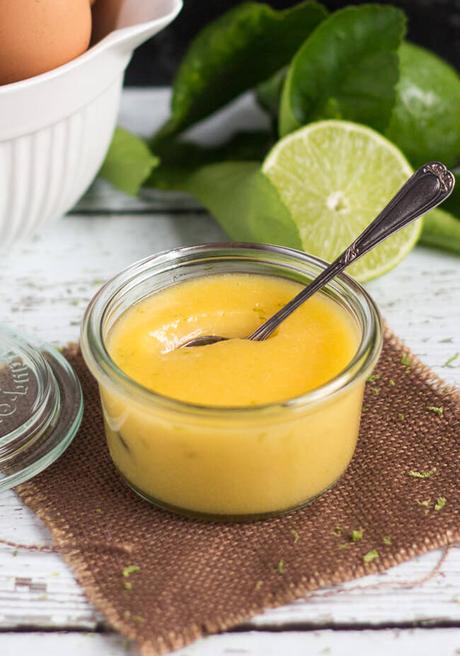
I have a problem. It is lime season and a friend of mine recently gave me a large bag of limes from her tree. Although that's not the actual problem.
My absolute favourite thing to make with limes is lime curd. And to make a true lime curd you need eggs. The real problem is that my chickens have chosen this time of year to shut up the egg laying shop and have a bit of a holiday. Which is very inconvenient indeed.
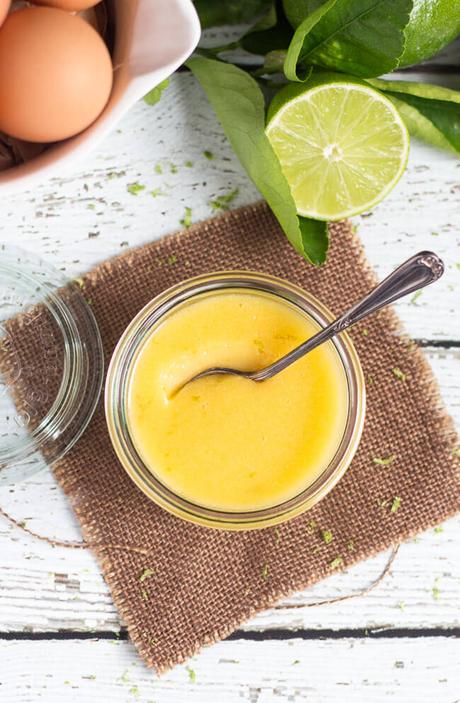
After a little bit of begging, I did manage to scrounge together enough eggs to make some lime curd. And I promise I didn't squeeze the chickens to do so.
*We are a participant in the Amazon Services LLC Associates Program, an affiliate advertising program designed to provide a means for us to earn fees by linking to Amazon.com and affiliated sites.
So Just What is Lime Curd?
Fruit curd, and specifically lime curd, is traditionally made using citrus juice, butter, sugar and eggs.
Whilst lemon is the most common type of citrus curd, curd can be made from any of the more acidic citrus varieties. I prefer lime curd, as I find it slightly less sweet than lemon curd. Limes aren't quite as acidic as lemons, so need less sugar to balance out the sharpness.
Curd can also be made with passion fruit, and I have on occasion turned a bountiful mulberry crop into mulberry curd.
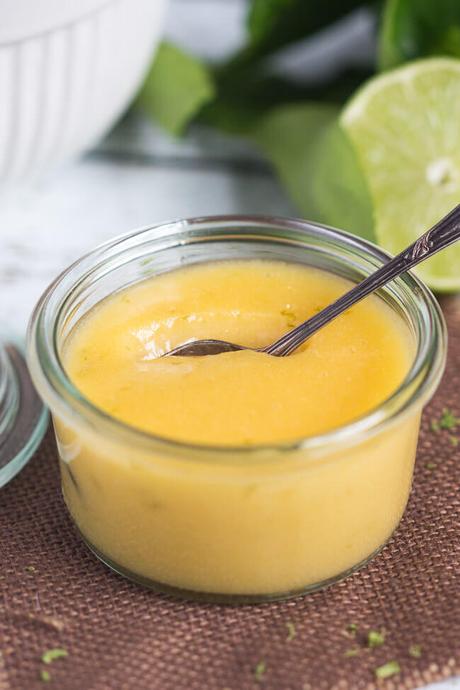
Homemade curd is a completely different product to anything you will buy in a jar from the supermarket. Those jars are full of added thickeners to achieve the consistency given by the eggs and butter, and stabilisers and preservatives to extend the shelf life.
Ingredient Substitutions for Making Lime Curd
It is difficult to recommend substitutions for this recipe. The butter and eggs are crucial to the texture of the lime curd, and there are no substitutes.
What you can play with is the type of sugar you use. I have a preference for raw sugar; I find it less sweet than highly refined white sugar, and I like the slightly caramel notes that it lends to everything. If white sugar is all you have on hand, use that instead, although I would reduce the amount in the recipe by approximately 1/4 cup.

You can also use this basic recipe to make lemon curd. Replace the lime juice with lemon juice, and increase the amount of sugar by 1/4 cup. If your lemons are particularly tart, you may need to add even more sugar. Mix the juice and sugar together first to ensure you have the balance right before adding the butter.
Tips & Tricks For Making Great Lime Curd
It is important to rely on visual cues rather than cooking time when making curd. If you have measured all of the ingredients correctly, the curd will thicken. You may just need to be patient. The actual time the curd takes to cook will be so dependent on your cooking set up i.e. the size of the bowl, the proximity of the bowl to the water, and the water temperature. I have had batches of lime curd take 30 - 40 minutes on the stove. If it seems that the curd is not thickening, try increasing the heat slightly under the pot.
Do not allow the water under the bowl to come to a vigorous boil. This is a sure-fire way to curdle your eggs. If the water does start to boil, remove the bowl and reduce the temperature under the saucepan. Make sure the water is gently simmering before replacing the bowl.
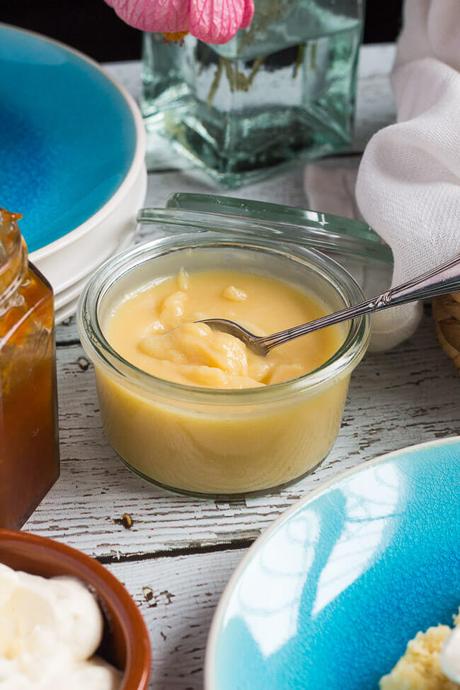
The lime curd is ready when it thickens and coats the back of the spoon. You should be able to draw a clear line through the curd.
#Homemade #lime #curd is infinitely useful in the kitchen. Slather it over #waffles, layer it in #breakfast parfaits or stir it through #yoghurt for a simple yet elegant #dessert. Or just eat it straight from the spoon. Click To Tweet
Many curd recipes advise you to sieve the eggs prior to adding them to the butter and sugar. This is to avoid little clumps of egg white in your finished product. I find if you whisk the eggs enough before adding them to the butter and sugar you can avoid this problem. If you do end up with wispy bits (and you care), you can sieve the curd prior to putting it in the jars.
If you are lucky enough to own a Thermomix or other thermal cooker, use that to make your lime curd. It is my preferred method, although I have provided instructions for both methods in the recipe below.
You do not need to sterilise the jars, however sterilising will significantly improve the keeping time of the curd. If you choose not to sterilise the jars I would only keep the curd for a maximum of two weeks in the fridge. In sterilised jars, my lime curd has a shelf life of about three months in the fridge, although I challenge you to keep it that long.
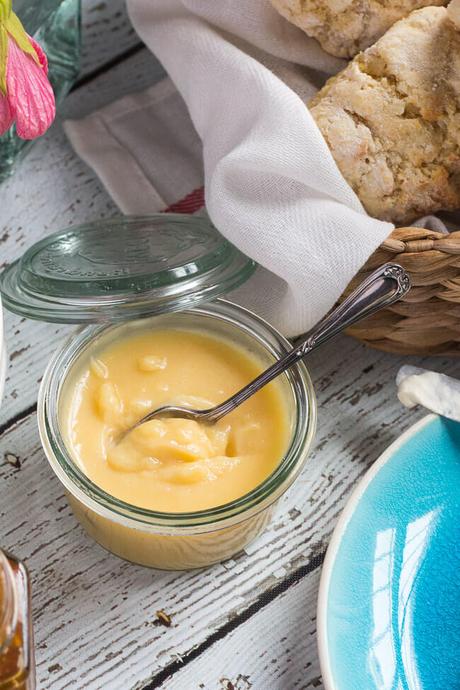
I prefer to sterilise my jars in the oven, as I find it easier. You can also run the jars through a dishwasher cycle, or cover them with water and boil them for ten minutes to sterilise them.
How To Use Lime Curd
Lime curd gets put to good use in our house. The Princess slathers it over homemade waffles for breakfast, or pikelets for afternoon tea. I have marbled it through yoghurt to create a quick dessert for unexpected guests, and it is amazing in breakfast parfaits.
Use your lime curd in any recipe that calls for lemon curd. It makes a great filling for mini tarts, or is delicious spread over plain scones. The Princess turns it into "an egg" - a puddle of yoghurt in a dish with a dollop of lime curd in the middle. I can think of worse things she could be eating.
And if you run out of ideas for using the last of the jar, you can always eat it straight off the spoon.
Enjoy!
Made this recipe? Tell me how it went in the comments below. And if you loved it, please don't forget to rate it.
TAKE MY FREE CHALLENGE. Find Mealtimes A Burden?
9 Days. 9 Tips. A Lifetime of Stress-Free Meals.
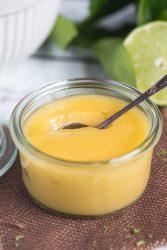
A Very Useful Lime Curd
Homemade lime curd is infinitely useful in the kitchen. Easy to make and delicious to eat. Slather it over waffles, layer it in breakfast parfaits or stir it through yoghurt for a simple yet elegant dessert. Failing that, just eat it straight from the spoon.
Makes 2 1/2 cups
Author Tania @ The Cook's Pyjamas (adapted from The WI Book of Jams & Other Preserves)
You will also need 5 or 6 125ml glass jars & lids
-
Preheat the oven to 120C.
-
Wash the jars and place them in the oven for 20 minutes.
-
When the time is up, turn the oven off but do not remove the jars.
Boil the lids in a saucepan for 5 minutes. Remove from the heat but do not drain the water.
To Sterilise The Jars
-
Gently stir until the butter is melted and the sugar has dissolved.
-
Pour the frothy eggs into the lime juice mixture, and stir gently to combine.
Continue to gently stir the mixture for about 15 minutes, or until the mixture has thickened and coats the back of a spoon.
To Make The Lime Curd - Stove Top Instructions
-
Insert the Butterfly into the Thermomix bowl.
-
Add all of the ingredients.
The mixture should have thickened and will coat the back of a spoon. If not, cook in 2 minute increments at 80C until the desired thickness is reached.
To Make The Lime Curd - Thermomix Instructions
-
Remove the warm jars from the oven and ladle the hot curd into the jars.
-
Wipe the rims of the jars with a clean cloth to remove any spills.
-
Remove the lids from the saucepan. Shake them well to remove excess water, then place on the jars.
Allow the sealed jars to cool, then label and date before storing in the fridge.
-
The sealed lime curd will keep for up to 3 months in the fridge.
Lime Curd Bottling Instructions
I usually sterilise my jars just before starting the recipe so they are still warm when I am ready to bottle the curd. You can sterilise the jars in advance, but make sure you re-warm the jars slightly before adding the curd or the jars may crack. I just do this by turning the oven back on for a few minutes.
The nutrition information for this recipe is provided as a guide only. Accurate information cannot be provided due to the nature of the recipe.
* Percent Daily Values are based on a 2000 calorie diet.
* This post was originally posted in May 2013. It has been substantially updated from the original post.
